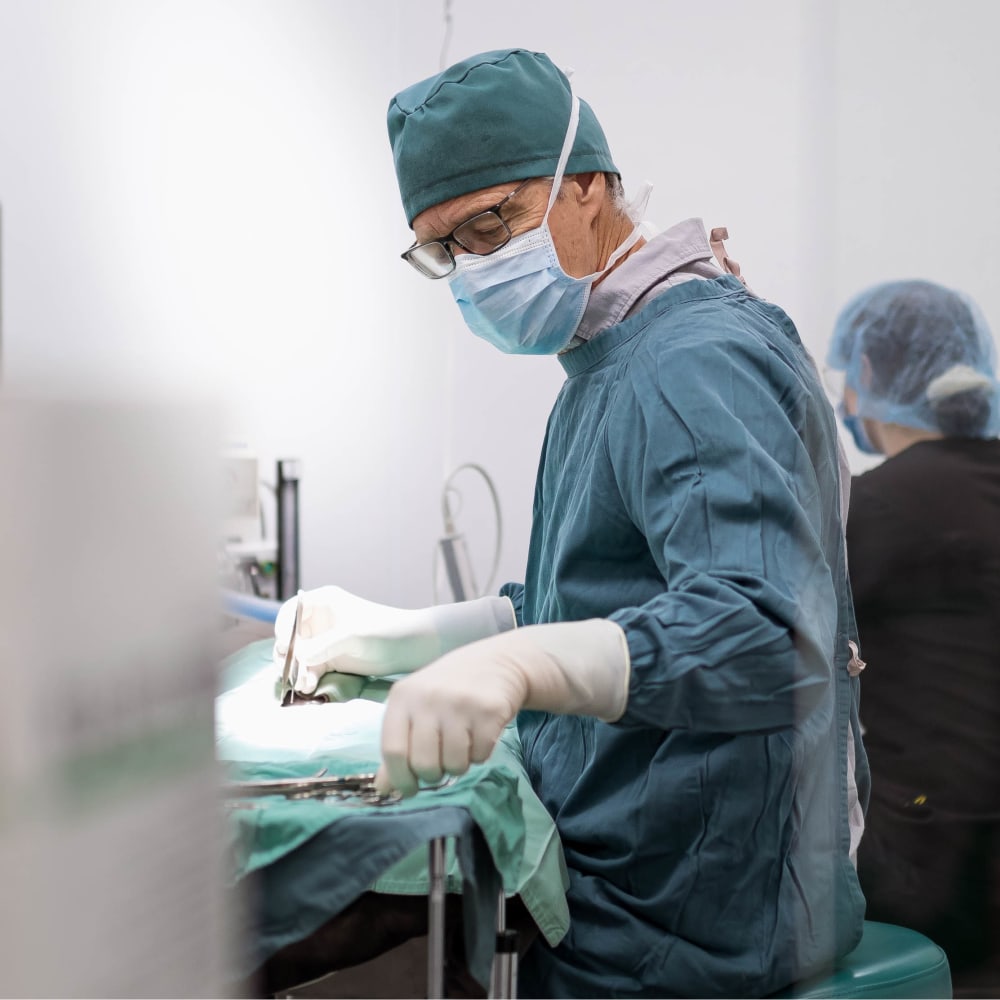Orthopedic Surgery
Correcting Bone & Joint Issues in Pets
Orthopedic injuries or diseases can affect bones, nerves, tendons, ligaments, or muscles. They can cause a great deal of pain, slowing your dog or cat's movements. You may notice that your once active companion is no longer as willing to run, jump, or walk like they used to.
When other treatment options prove ineffective for your pet's orthopedic issues, surgery may be able to help reduce your pet's pain and improve their quality of life.
At Pawsitive Veterinary Care, we typically refer our patients to a local veterinarian, Dr. Bhandal. However, we also offer a limited number of orthopedic procedures in-house.

Veterinary Orthopedic Surgeries
At Pawsitive Veterinary Care, we offer the following orthopedic surgeries to treat bone and joint issues, and help dogs and cats get back to running and playing as comfortably as possible:
-
Femoral Head Osteotomy (FHO)
This surgical procedure can treat numerous hip problems in cats and dogs, including dislocation, luxation, arthritis, and dysplasia.
During the surgery, the veterinarian will remove the femoral head, leaving your pet's hip socket empty. Your pet's leg muscles will initially hold the femur in place. Eventually, scar tissue will develop between the femur and the socket of the hip bone, creating a "false joint". The scar tissue will act as a cushion between your pet's bones.
-
Surgical Fracture Repair
Fractures are some of the most common orthopedic problems diagnosed in dogs and cats. They usually happen due to an accident with a motor vehicle.
Sometimes, we can apply a cast to treat the broken bone. However, many fractures will require surgical intervention. Depending on the repair that is needed, the procedure may include one of the following techniques:
- Pinning – A long, stainless steel rod is inserted into the middle of the bone across the injured area to stabilize the fracture.
- Plating – The veterinarian can use screws to attach a flat, stainless steel plate to the bone on either side of the fracture.
- External Fixation – Pins are passed through the outside of the leg, through the skin, and into each bone and bone fragment, and out through the skin on either side of the fracture to stabilize a limb. Your veterinarian will then attach the ends of the pins protruding from the skin's surface to a rigid external frame that will hold them in the correct position.
-
Tibial Plateau Leveling Osteotomy (TPLO)
A veterinarian can perform this surgical procedure to repair tears in a dog or cat's cranial cruciate ligament (CCL). The procedure can help stabilize the stifle joint (similar to a human's knee joint), relieve pain, and prevent further damage.
TPLO surgery is designed to change the biomechanics of the knee so that it functions without requiring the cruciate ligament for stability. During TPLO surgery, the veterinarian cuts the top of the tibia (the bone beneath the knee) and rotates it. Bone plates and screws are placed to stabilize the tibia. These changes impact the movement of the knee and compensate for loss of function in the CCL.
In many cases, pets will return to normal activities after recovering from this surgery.
-
Tibial Tuberosity Advancement (TTA)
When TTA surgery is performed, the front part of the tibia (shin bone) is cut and separated from the rest of the bone. Next, a special orthopedic spacer is screwed into the space between the two sections of the tibia to move the front section forward and up.
By doing this, the patellar ligament which runs along the front of the knee is moved into better alignment and helps limit the abnormal sliding movement that causes much of the pain experienced by dogs with cruciate injuries.
Once this process has been completed, a bone plate will be attached to hold the front section of the tibia in its proper position.
Orthopedic Surgery FAQs
If your pet is scheduled for orthopedic surgery, take a few minutes to browse through the answers to these frequently asked questions from our clients.
-
What happens during the surgical consultation?
During the surgical consultation, we will perform a physical exam and review your pet’s medical history. Bloodwork and other diagnostic tests may be performed to provide further details about your pet's condition. Your dog or cat's diagnostic testing may include X-rays, an ultrasound, or biopsies.
Based on the results of your pet's tests, a plan for surgery will be developed and discussed with you.
-
Will the surgery and consultation happen on the same day?
No. The consultation appointment is required for testing and examination, to determine the nature and extent of your pet's health problem. Once the results from your pet's diagnostic tests are available from our lab, a surgery appointment can be scheduled.
-
How long will the surgery take?
Orthopedic surgeries typically last between two to four hours. That said, times vary and the amount of time your pet's surgery will take depends upon the type of surgery being performed and your pet’s specific condition.
-
Does my pet have to stay at the hospital overnight either before or after the surgery?
Depending on the time of day that the surgery is scheduled, it may be necessary to drop your pet off the night before.
Many of our patients need to stay with us overnight after surgery so that we can monitor them as they recover. Depending on the type of surgery that is performed and how quickly they recover after anesthesia and surgery, your pet may be able to go home on the same day. Your veterinarian will let you know the requirements of your pet's specific procedure during your consultation.
New Patients Welcome
Pawsitive Veterinary Care is accepting new patients! Our experienced veterinarians are passionate about the health of Kelowna's dogs and cats. Get in touch today to book your pet's first appointment.
